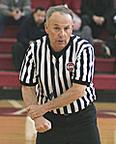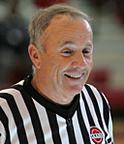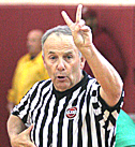With Veteran Official Skip Yutzler
Ask The Ref !
Do you have a question?
Have you seen a play you didn't understand? Was there a controversy you'd like clarified? Send your questions in and I'll do my best to get you an answer!
2019-2020 SEASON
ASK THE REF/FEBRUARY
1. QUESTION: Dribbler A-1 is in control of the ball in his front court when a defender swats the ball away. Players for both teams are in hot pursuit trying to grab the loose ball. Player B-2 comes flying out of the crowd, dives on the loose ball and after gaining control he slides almost 10 feet along the floor. Is this a traveling violation?
ANSWER: NO. The play above is considered an exception to the traveling violation. By rule, player B-2 has done nothing wrong as described. BUT, if B-2 attempts to stand up or roll over, the exception would end and a traveling violation would be called.
2. QUESTION: Offensive player A-4 attempts a shot from the corner. The ball hits the front of the goal and caroms in the direction of the division line at mid-court. Multiple players attempt to grab the ball with no luck. Finally, player A-3 (on the offensive team) gets a hand on the ball while in his front court and causes the ball to bounce into the back court where his teammate, A-4, is first to touch the ball. The crowd is screaming for a violation but the official doesn't blow his whistle. Is the official correct?
ANSWER: Absolutely, YES. The key to this play is that "team control" ends when a player on Team A releases a "try for goal" (also known as a "shot"). By rule, the missed shot is no longer in control of either team. When A-3 gets a hand on the ball but fails to control it in the front court, it is still not in control of a player. The ball enters the back court without being caused to go there by a team in control. So it is perfectly legal for A-4 to regain control in the back court without a violation being called.
3. QUESTION: Team A has the ball for a throw in from a designated spot along the end line. Player A-5, a 6'9" center is clearly standing in the middle of the foul lane hoping to get a lob pass from his teammate handling the throw in. The coach of Team B is screaming for a 3-second violation. It the coach correct?
ANSWER: NO. By rule, there is "no team control" during a throw in. So the fact that A-5 is camping out in the foul lane is irrelevant up until the time a throw in is made and controlled by a member of Team A. At that point the 3 second count will begin.
4. QUESTION: As above, Team A has the ball for a throw in from a designated spot along the end line. As the administering official nears making a call for a 5 second violation, the ball is released for a throw in directed toward his teammate, A-3 at the top of the key. A-3 is unable to catch the ball even though it clearly hits his hand and then goes into the back court where teammate A-2 runs it down. The deflection by A-3 is clearly visible and the coach of Team B is insisting that a back court violation has occurred. Is the coach correct?
ANSWER: Nope. By rule, there is "no team control during a throw in" from any point on the court. It makes no difference if the throw in is from the front court or back court, nor does it matter where the ball ends up after the deflection by A-3. The "touching" of the ball does not constitute "gaining control." So the ball that ends up in the back court remains "not in control" until either team gains control.
5. QUESTION: To start the second half, Team B gets the ball by virtue of the AP (alternate possession) arrow. Team A plays aggressive defense and Team B is unable to release the inbounds pass in the required 5 seconds. The official whistles a throw in violation on Team B and awards the ball to Team A. The official realizes that the throw in was not completed (that is, it was not "legally touched by a player") and determines that the AP arrow should NOT be changed. Is this correct?
ANSWER: Sadly, NO. The official has forgotten that, by rule, a VIOLATION by the throw in team actually causes the AP throw in to end AND it causes the throw in team to lose both the ball and the AP arrow. (double jeopardy!) The ball is awarded to Team A and the arrow is switched so that the next AP arrow will be for Team A. (Case Book play #6.4.5 - Situation A)
49 Years High School and Junior College Official. Selected 5 times to officiate at the New York State High School Championships





